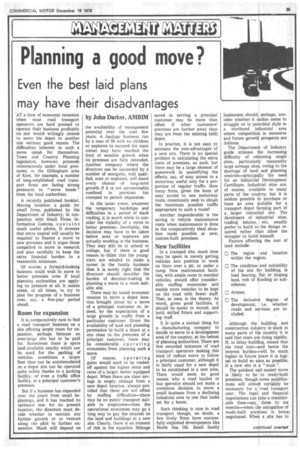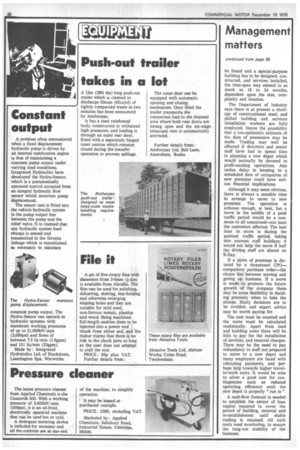Planning a good move?
Page 41

Page 42

If you've noticed an error in this article please click here to report it so we can fix it.
Even the best laid plans may have their disadvantages
by John Darker, AMBIM
AT a time of economic recession when most road transport operators are hard pressed to operate their business profitably no one would willingly choose to move his depot to another site without good reason. The difficulties inherent in such a move speak for themselves. Town and Country Planning legislation, however, proceeds remorselessly under local pressures; in the Gillingham area of Kent, for example, a number of long-established road transport firms are facing strong pressures to "move house " from the local authorities.
A recently published booklet, Moving location: a guide for small firms, published by the Department of Industry, in conjunction with Small Firms Information Centres, co n t a i ns much useful advice. It stresses that extra capital will usually be required to finance a move to new premises and it urges those compelled to move to research and plan carefully to keep the extra financial burden to a reasonable minimum.
Of course, a forward-looking business could wish to move to better premises even if local planning authorities are applying no pressure at all. It makes sense, at all times, to try to plan the progress of a business over, say, a five-year period ahead.
Room for expansion
It is comparatively rare to find a road transport business on a site offering ample room for expansion, perhaps because an over-large site has to be paid for. Sometimes there is spare land available nearby which can be used for the parking of vehicles; sometimes a larger fleet than can be accommodated on a depot site can be operated quite safely thanks to a parking facility, or even a traffic office facility, at a principal customer's premises.
But if a business has expanded over the years from small beginnings, and it has reached its optimum size for its present location, the directors must decide whether to restrain any further growth or to venture along the path to further expansion Much will depend on the availability of management potential over the next few years. A haulage business run by a man of 55 with no children or nephews to succeed the main owner may have reached the limit of sensible growth when its premises are fully extended. Another company where the directors can be succeeded by a number of energetic, well qualified, sons or nephews, will stand every chance of long-term growth if it is not unreasonably confined in premises too cramped to permit expansion.
In the latter event, whatever the temporary hardships and difficulties in a period of slack trading, it is worth while to consider the viability of a move to better premises. Inevitably, the decision may have to be taken before sons or nephews are actually working in the business. They may still be at school or college, but if there is good reason to think that the youngsters are minded to make a career in the family business then it is surely right that the directors should shoulder the burden of decision-making in planning a move to a more suitable site.
There may be sound economic reasons to move a depot location brought about by a move of a principal customer or, indeed, by the expectation of a large growth in traffic from a particular customer. Given the availability of land and planning permission to build a depot at a site close to the premises of a principal customer, there may be considerable operating economies from planning such a move.
Of course, operating gains would need to be tradedoff against the higher rents and rates of a larger, better equipped depot. When there are clear savings in empty mileage from a new depot location, always provided that these are not offset by staffing difficulties—there may be no public transport suitable to employees—then the operational economies may go a long way to pay the interest on the land and buildings at a new site. Clearly, there is an element of risk in the equation. Mileage saved in serving a principal customer may be more than offset if other customers' premises are further away than they are from the existing (old) depot.
In practice, it is not easy to estimate the cost-advantages of a new site. There is no special problem in calculating the extra costs of premises, as such, but there may be a large element of guesswork in quantifying the effects, say, of easy access to a motorway useful only for a proportion of regular traffic. How many firms, given the boon of easy access to one motorway route, consciously seek to obtain the maximum possible traffic appropriate to such a route?
Another imponderable is the saving in vehicle maintenance costs when maintenance is done in the comparatively ideal situation made possible at new, custom-built premises.
New facilities
In a cramped site, much time may be spent in merely getting vehicles into position to work on them over a pit, or under a ramp. New maintenance facilities, with ample room to marshal vehicles, should offer considerable staffing economies and enable more vehicles to be kept on the road with fewer staff. That, at least is the theory. At worst, given good facilities, it should be easier to recruit, and hold, skilled fitters and supporting staff.
It is quite a normal thing for a manufacturing company to decide to move to a development area of the country, at the behest of planning authorities. There are few recorded instances of road transport operators making this kind of radical move to follow a principal customer, although it is fairly usual for a new depot to be established in a new area. There would seem no good reason why a road haulier or bus operator should not make a conscious decision to move a small business from a declining industrial area to one that looks set for a boom.
Such thinking is rare in road transport though, no doubt, a few lively firms have successfully exploited developments like North Sea Oil. Small family businesses should, perhaps, consider whether it makes sense to struggle on in parochial style in a moribund industrial area where competition is excessive and future growth prospects are dubious.
The Department of Industry guide stresses the increasing difficulty of obtaining single sites, particularly reasonably large acreage sites, owing to the shortage of land and planning controls—principally the need for an Industrial Development Certificate. Industrial sites are, of course, available in many parts of the country, but it is seldom possible to purchase or lease an area suitable for a transport depot forming part of a larger industrial site. The developers of industrial sites, trading estates, etc, usually prefer to build to the design required rather than allow the occupier to build himself.
Factors affecting the cost of land include:
El The region and location within the region; El The condition and suitability of the site for building, ie load bearing, flat or sloping land, risk of flooding or subsidence;
0 Access; [:] The inclusive degree of development, i.e. whether roads and services are included.
Although the building and construction industry is slack in many parts of the country it is said that costs are rising rapidly. If, to delay building, means that the total cost—and hence the interest burden—will be much higher in future years it is logical to build as soon as possible, if a new site is a "must ".
The quickest and easiest move is likely to be ' to ready-built premises, though some modifications will almost certainly be necessary for a road transport user. The legal and financial negotiations can take a considerable time—say, three to six months—when the occupation of ready-built premises is being r negotiated. When a site has to be found and a special-purpose building has to be designed, constructed, and services installed, the time-span may extend to as much as 18 to 24 months, dependent upon the size, complexity and location.
The Department of Industry says there is at present a shortage of constructional steel, and skilled building and services installation workers are fully employed. Hence the possibility that a too-optimistic estimate of the date of possession may be made. Trading may well be affected if directors and senior staff have had to spend time in planning a new depot which would normally be devoted to profit-earning operations. Any undue delay in keeping to a scheduled date of occupation of new premises could have serious 'financial implications.
Although it may seem obvious, there is always a sensible time to arrange to move to new premises. The operation is arduous enough, at best, but a move in the middle of a peak traffic period would be a nonsense to all concerned—not least the customers affected. The best time to move is during the quietest traffic period, taking into account staff holidays; it would not help the move if half the driving staff are absent on R-Day.
If a move of premises is dictated by a threatened CPO— compulsory purchase order—the choice lies between moving and giving up business. If a move is made to promote the future growth of the company there may be some flexibility in deciding precisely when to take the plunge. Hasty decisions are to be avoided, and expert advice may be worth paying for.
The cost must be counted and the sums must be calculated realistically. Apart from land and building costs there will be bills to pay for the installation of services, and removal charges. There may be the need to pay redundancy to staff not prepared to move to a new depot and many employers are faced with rehousing payments, and perhaps help towards higher travelto-work costs. It would be wise to allow a good sum for contingencies such as reduced operating efficiency until the new depot is properly "run in ".
A cash-flow forecast is needed to establish the extent of loan capital required to cover the period of building, removal and re-establishment until stable trading is resumed. All such costs need monitoring, to ensure the long-run stability of the business.












































































